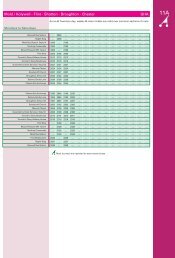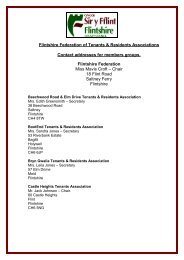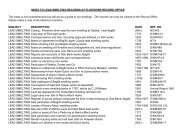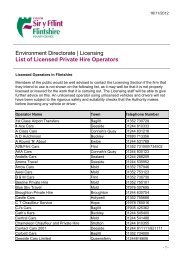Caerwys Eng.indd - Flintshire County Council
Caerwys Eng.indd - Flintshire County Council
Caerwys Eng.indd - Flintshire County Council
Create successful ePaper yourself
Turn your PDF publications into a flip-book with our unique Google optimized e-Paper software.
Welcome to<br />
<strong>Caerwys</strong><br />
<strong>Caerwys</strong>, the smallest town in Britain with a Royal Charter, has<br />
a long and fascinating history. The numerous Bronze Age burial<br />
mounds, other Bronze Age finds such as the gold torc, and the Iron Age<br />
hillfort on nearby Penycloddiau indicate that the area was well-used by<br />
Prehistoric tribes. Romans probably traded locally and, by 1086, <strong>Caerwys</strong><br />
was of sufficient importance to merit a mention in the Domesday Book.<br />
The town is proud of its royal connections. In the 11th and 12th<br />
centuries it had strong links with the Princes of Gwynedd who had a<br />
palace at Maesmynan. In 1290, Edward I granted the town its Royal<br />
Charter, making it a free borough. It was<br />
one of 10 towns in North Wales that were<br />
granted charters, but the others were all<br />
Norman fortified towns, such as Rhuddlan,<br />
Flint and Conwy, where the local Welsh had<br />
limited rights. <strong>Caerwys</strong> was unique as it was<br />
the only truly Welsh settlement granted this<br />
privilege.<br />
The town continued to flourish and enjoy<br />
royal patronage throughout the Medieval and<br />
Tudor periods. Not only was it a commercial<br />
centre, but it also had strong Welsh cultural<br />
traditions, and is known as the birthplace<br />
Research: Lorna Jenner, Berwyn Roberts, John Rees,<br />
the late Tom Lloyd-Roberts, the authors of the <strong>Caerwys</strong><br />
Guide, 1979, <strong>Caerwys</strong> Historical Society<br />
Scripting: Lorna Jenner<br />
Design: William Smuts<br />
Printing: Design and Print 01352 704000<br />
Wildlife photography: Steve Young, Simon Booth<br />
Photographs: Christine Griffiths, Lorna Jenner, Dilys<br />
Jones, Vicky Jones, Annette Jones, Estelle Parry, Phillip<br />
Parry, Elvet Pierce, Neville Pierce-Jenkins, John Rees,<br />
Berwyn Roberts, Alan and Julie Thomas, Tom Wood<br />
of the eisteddfod in North Wales. Its long<br />
musical tradition is maintained today<br />
through its Male Voice Choir and Christmas<br />
carols on the Square.<br />
By the 19th century the regional importance<br />
of <strong>Caerwys</strong> was declining, despite the opening of<br />
the Mold to Denbigh railway line. New main roads had bypassed the<br />
town and the nearby towns of Flint and Holywell prospered as industry<br />
developed. <strong>Caerwys</strong> remained predominantly rural. Eight mills ground<br />
corn on the Afon Wheeler and the regular livestock markets continued to<br />
flourish into the 20th century. Farming remains important today, with<br />
the annual Agricultural Show drawing crowds from miles around.<br />
The trains brought day trippers and holidaymakers to the area, attracted<br />
by the historic town and the picturesque countryside. Many camped<br />
on farms or rented rooms from local people and gradually permanent<br />
caravan parks and holiday accommodation developed.<br />
Local residents and visitors alike continue to enjoy <strong>Caerwys</strong>, with its<br />
thriving and vibrant community.<br />
This booklet has been produced by the local community to<br />
celebrate the rich cultural and natural heritage of the area. Many<br />
thanks to all who have provided photographs or shared their<br />
memories and knowledge.<br />
The booklet can also be downloaded from www.cadwynclwyd.<br />
co.uk or www.flintshire.gov.uk/tourism









